How to Cite | Publication History | PlumX Article Matrix
Cytogenotoxic Effects of Ferula asafoetida as Homoeopathic Drug in Vicia faba
Sangeeta Dayal1, Alka Noopur1 and Harshal Kumar2
1Department of Bio-TechnologyMonad University, N.H-24, Delhi Hapur Road P.O. Pilkhuwa-245304, Distt- Hapur (U.P.) India.
2National Bureau of Plant Genetic Resources; IARI PUSA; New Delhi.
Corresponding Author E-mail: sangeetadayal2009@gmail.com
DOI : http://dx.doi.org/10.13005/bbra/2647
ABSTRACT: Extract of Ferula asafoetida (Heeng) is commonly used as Homoeopathic drug to cure various stomach related problems. There has been significant controversy associated with the side effects of Homoeopathic drugs. The effects of different concentrations of heeng on the chromosomes of Vicia faba was investigated. 5%, 10%, 20% & 30% of Ferula asafoetida were used for 4hrs, 8hrs, 12hrs and 24 hrs followed by acetocarmine squash procedure. All the concentrations showed mitoinhibitory effect in root tips of Vicia faba and also observed so many chromosomal aberrations (clastogenic). The most observed aberrations were sticky chromosomes, chromatin bridges, chromatin fragments and laggards at every stage of mitotic division . The result of present study clearly established the cytogenotoxic behaviour of heeng as Homoeopathic drug.
KEYWORDS: Clastogenic; Cytogenotoxic; Ferula Asafoetida; Homoeopathic Drug; Vicia faba
Download this article as:| Copy the following to cite this article: Dayal S, Noopur A, Kumar H. Cytogenotoxic Effects of Ferula asafoetida as Homoeopathic Drug in Vicia faba. Biosci Biotech Res Asia 2018;15(2). |
| Copy the following to cite this URL: Dayal S, Noopur A, Kumar H. Cytogenotoxic Effects of Ferula asafoetida as Homoeopathic Drug in Vicia faba. Biosci Biotech Res Asia 2018;15(2). Available from: https://www.biotech-asia.org/?p=30314 |
Introduction
Man established many virtues of natural resources in the field of medicine. The therapeutic agents obtained from plants are used in various system therapeutic viz Homoeopathy, Ayurvedic etc. Homoeopathy is a system of medicine in which the indigenous & crude plant/ animal products are used in medicine. Homoeopathy work on the “Law of simplex” it means administration of a single remedy should be prescribed at a time because when two substrate are mixed together either they form third substance or some of their own properties are lost, so Homoeopathy up holds monopharmacy. In the 4 century B.C. Hippocrate the father of modern medicine observed that large amount of certain natural substances can produce, symptoms in healthy people resembling those caused by these substances can relieve those symptoms, this is the base of Homoeopathy.
Homoeopathy is a form of medicine in which drugs treat whole body & helps it to heal itself. It can be used for the acute & chronic illness in low & high potencies respectively. In this double blind placebo controlled trial, 50 The effects of Aconite were comparatively found better than placebo when Libeu JP, Jobert J. in 1990 were treated children post-operative pain and agitation were given either Aconite or placebo. According to Frei H, Thurneysen 2001 children suffering from acute otitis media, with homoeopathic treatment was compared with placebo to determine whether homoeopathic treatment provided a faster resolution of symptoms than placebo.Gmnunder R, Kissling R. ( 2002). In this controlled, randomised, prospective study, 43 people suffering from chronic low back pain were treated for two months either by homeopathy or by standardized physiotherapy, resulted that the most successful method of treatment was homeopathy.
Frenkel M, Hermoni D.( 2002) has studied on 48 patients were treated for allergic disorders with both homoeopathic and conventional medicines, and monitored for their level of use of the conventional medicines. After 3 months observations, 56% of patients were reduced their conventional medication use by an average of 60%.They observed that homeopathy is better than other kind of medications.
Homoeopathic drugs obtained through various sources like vegetable sources, animal sources, chemical mineral sources etc. The mother tincture is prepared from the whole plant or from the part of it. There are so many extract of plants which are used as Homoeopathic drugs.
The extract of Ferula asafoetida (Heeng) is one of the important & popular Homoeopathic drugs. Heeng is an aromatic gum resin which is obtained by inscision from the carrot shaped roots of plant Ferula asafoetida. This gum resin is grayish or dull yellow in color & consist of organic sulphar compound, volatile oil 5%, containing essential oil of garlic lolly, ally persulphide & turpenes a resin 65%, a ferulic acid, ester oil asaresinotannol free ferulic acid, gum 25% & ash 4%.
Heeng act as stimulant, carminative antispasmodic, expectorant & also antihelminthic diuretic, aphrodisiac & emmenagogue. It is a nervous & pulmonary stimulant & also increases the sexual appetite. Heeng is popular in India for the use like flavoring agent ,as an ingredient in condiments & in many spices mixture. It is fried before being used, raw and unfried heeng cause vomiting. As anesthetic, asafoetida is employed in nemicrania & dental caries. Heeng is also given to increase the lochial after child birth.
Material and Method
The mother tincture of Ferula asafoetida has been purchased from RSBP Bulandshahar & Lord Pharmacy New Delhi. Mother tincture of heeng along with different titration & potencies are used in this investigation.
The seeds of test plant Vicia faba were obtained locally & central state farm C.S.F. Behraich U.P.
Mother tincture of heeng prepared by mixing a particular volume of drug in measured volume of distilled water , by this methods we have prepared 5%,10%,20%,30% solution of heeng .
Mitotic Studies
The effect of heeng as Homoeopathic drug on somatic cell division have been studied by root tip method.
The healthy seed of Vicia faba have been germinated on moist filter paper in sterilized petridishes.
The root tips then 2-3 mm long were subjected in to 5%,10%,20%,30% conc. For 4hrs, 8hrs, 12hrs & 24hrs treatments. After treatment of root tips were rapid washed with tap water.
Root tips were Fixed in Carnoy’s fluid (Ethanol (CH3CH2OH): It is used as a major constituents in fixative used in various combinations\proportions with other acids. It has immediate penetration ability by dehydrating the tissues and also denature the proteins for 6-14 hrs & then transferred in 70% of alcohol at 40The most widely used fixatives described by Sharma and Sharma (1972).
Slides have been prepared by acetocarmine squash technique(Darlington and La Cour, 1969; Sharma and Sharma, 1972; Fukui and Nakayama, 1996. Jahier, 1996,
The observations were taken under the 100x lens with oil emersion.
After taking observations the microphotographs were taken by Olympus 35 mm camera using Nova, Orvo plus 21 Din or 125 ASA.
Observations
Heeng have shown a conc. dependent occurrence in many aspects of cellular division. The slides showed inhibition in MI, so many disturbances in structure, appearance and behavior of dividing chromosomes. Chromosomal disturbances increased with increasing conc. & duration of treatment. The treated root tips showed various disturbances at prophase, metaphase and anaphase stage of mitotic cell division. Due to disturbed or abnormal cell division the offspring cells will carry parental type of abnormal chromosomes. The observations are as follows:
Mitotic Index
The mean percentage of mitotic index (MI) was significantly decreased from 12.8 to 12.00 after 24 hrs treatment, as compared to control text. The mitotic index was 14.00-13.6. The higher volume of MI was noticed in 5% conc. of heeng in all duration & the lower volume was observed in 30% of that Homoeopathic drug. The mitotic index significantly decrease with increasing concentration of heeng (Table -1). So that observations clearly indicated that heeng was observed to be inhibit the cells to be divided. The no of dividing cells treated were found less than the no of dividing cells found in control or untreated cells with the drug.
Chromosomal Observations
The microslides prepared by squash technique showed various chromosomal abnormalities. Table-1 gives percentage of different chromosomal abnormalities caused by different conc. & duration of heeng treatment . The normal behavior of chromosomes were observed in control slides (Plate-1, Fig-1,2,3,4 ,Table -1).
The stickiness of chromatids at prophase were observed frequently in higher conc. of heeng solution ( Plate -2, Fig-1,Table -1). Stickiness of chromosomes were also observed at metaphase ( Plate-2, Fig-2) in all the conc. & duration of treatment viz 5%, 10 %, 20%, 30% & 4 to 24 hrs of Ferula (Table -1).
The mean percentage of sticky chromosomes was increased with increase in conc. & duration. The mean percentage was increased from 16.02-16.00 (Table -1) with their conc.
The Ferula treatment inactivates the spindle, resulting in the scattering of chromosome (Plate-2, Fig -3) associated in to there are four groups due to more than one spindle at metaphase. About 1.02-1.56% of multipolars were observed (Table -1).
Due to stickiness of chromosomes the separation of chromosomes was affected as formation of chromatin bridges. The chromatin bridges leads to incomplete division of cell or abnormal cell division. Single , double and multi chromatin bridges were observed only in higher conc. of Ferula in Vicia faba. The highest percentage of bridge was 3.78 in Vicia ( Table -1).
The breaking or fragmentation in chromosomes were also found in many slides. Fragments of chromosomes observed from 4.9 to 5.55 (Table -1) in Vicia ( Plate-2, Fig -5).
Lagging chromosomes were also observed in some slides in higher percentage in Vicia (Plate-2, Fig-6). The laggard was 1.11. The lagging chromosomes leads to formation of micronuclei (Table -1).The microphotographs are shown in Plate-1 and Plate -2.
Plate 1: Control
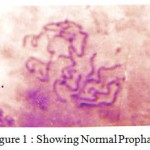 |
Figure 1: Showing Normal Prophase
|
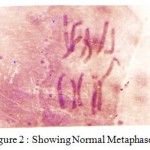 |
Figure 2: Showing Normal Metaphase
|
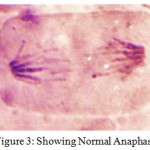 |
Figure 3: Showing Normal Anaphase
|
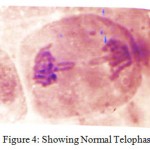 |
Figure 4: Showing Normal Telophase
|
Plate 2: Chromosomal Abnormalities After The Treatment of Heeng.
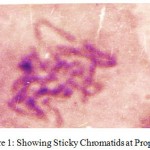 |
Figure 1: Showing Sticky Chromatids at Prophase
|
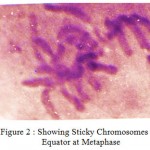 |
Figure 2: Showing Sticky Chromosomes on Equator at Metaphase
|
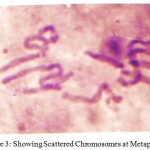 |
Figure 3: Showing Scattered Chromosomes at Metaphase
|
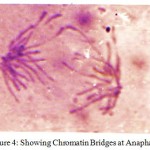 |
Figure 4: Showing Chromatin Bridges at Anaphase
|
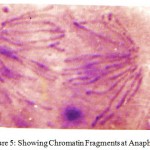 |
Figure 5: Showing Chromatin Fragments at Anaphase
|
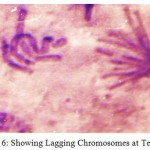 |
Figure 6: Showing Lagging Chromosomes at Telophase
|
Table 1: Type and distribution of somatic chromosomal abnormalities in (%) include by different conc. and duration of Ferula asafoetida (Root-tip treatment) in Vicia Faba.
| Duration | Con. in % | Total cell observed | Mitotic Index | Condensed & sticky chromosomes | Multi polar | Fragments | Chromatin Bridges | Multi nucleates | Laggards | Total Aberrations In (%) |
| Control | 440 | 14 | 1.31 | – | – | – | – | – | 1.31 | |
| 5 | 400 | 13.61 | 14.2 | – | 4.41 | 2.09 | – | – | 20.7 | |
| 4 hrs. | 10 | 390 | 12.98 | 15 | – | 4.92 | 2.61 | – | – | 22.5 |
| 20 | 398 | 12.82 | 17 | 1.61 | 5.12 | 3.21 | – | 1.09 | 28 | |
| 30 | 380 | 12.56 | 17.9 | 2.5 | 5.4 | 3.52 | 0.51 | 2.04 | 31.8 | |
| Mean | 392 | 12.41 | 16.02 | 1.02 | 4.9 | 2.85 | 0.12 | 0.78 | 25.75 | |
| Control | 450 | 13.8 | 1.41 | – | – | – | – | – | 1.41 | |
| 5 | 410 | 13 | 14.5 | – | 4.61 | 2.7 | – | – | 21.81 | |
| 8 hrs. | 10 | 395 | 12.6 | 15.7 | 1.21 | 5.12 | 3.1 | – | – | 25.13 |
| 20 | 392 | 12.6 | 17.6 | 1.82 | 5.57 | 3.51 | – | 2.18 | 30.68 | |
| 30 | 385 | 12 | 18 | 2.81 | 5.81 | 4.62 | 0.52 | 2.21 | 33.97 | |
| Mean | 395.5 | 12.85 | 16.45 | 1.46 | 5.27 | 3.47 | 0.13 | 1.09 | 27.89 | |
| Control | 451 | 12.09 | 1.42 | – | – | – | – | – | 1.42 | |
| 5 | 412 | 12.6 | 14.6 | – | 4.81 | 2.91 | – | – | 22.32 | |
| 12 hrs | 10 | 391 | 13 | 15.1 | 1.32 | 5.5 | 3.47 | – | – | 25.39 |
| 20 | 389 | 12.7 | 17.8 | 2.02 | 5.97 | 3.86 | – | 2.19 | 31.9 | |
| 30 | 378 | 13.2 | 18.9 | 2.91 | 6 | 4.91 | 0.61 | 2.25 | 35.58 | |
| Mean | 39.25 | 12.8 | 16.6 | 1.56 | 5.55 | 3.78 | 0.15 | 1.11 | 28.79 | |
| Control | 441 | 13.6 | 1.26 | – | – | – | – | – | 1.26 | |
| 5 | 411 | 12.9 | 14 | – | 4.21 | 2.61 | – | – | 20.82 | |
| 24 hrs. | 10 | 392 | 12.8 | 14.6 | – | 4.62 | 3.07 | – | – | 22.29 |
| 20 | 386 | 12.5 | 15.5 | – | 4.98 | 3.12 | – | – | 23.6 | |
| 30 | 365 | 12 | 16.4 | 1.46 | 5.61 | 4 | 0.31 | – | 27.78 | |
| Mean | 388.5 | 12.55 | 15.12 | 0.36 | 4.85 | 3.2 | 0.07 | – | 23.62 |
Result and Discussion
The present investigation has proved the chromotoxic behaviour of heeng as Homoeopathic drug. Various types of cytological & cytogenetical aberrations were observed by biological testing of heeng as Homoeopathic drug on Vicia faba plant.
The mitotic index inhibit by the effect of heeng with increase in concentration & duration. Kuras et al (2009) found alkaloids from Licaria fomentosa bark were retard or inhibit mitosis & change mitotic phase in Allium cepa. Palani & Pannerselvam (2007) tested cytogenetic effect or mitotic effect of food preservation on root tips of Allium cepa. Amato (1949, 1952) suggested that reduced MI by the chemical mutagens has resulted due to prophase poisoning and restriction of the dividing cells of prophase or interphase. Chandra et. al. (1989) reported that the certain Homoeopathic drugs are also pressive due to inhibition of cell division & germination of spores in various fungi. Sadia & Vahidy (1994), Kumar and Shrivastva (2011) reported that boron as food preservative disturb the normal cell cycle & reduced the mitotic index ( Abdel-Hady and Barakat 2005, Sifa 2007).
In present investigation sticky chromosome were the most prominent abnormality found in prophase, metaphase & anaphase also by the effect of heeng. It was also reported by Chidambaram et al (2009).
The sticky chromosomes may be due to the diverse correlation in the hetero spaceless chromatin & euchromatin contents. Golden et al (1987) reported that sticky chromosome may be resulted from defective functioning of one or two types of specific non-histone proteins. Stickiness may result from chromatin fibers sticking to each other or breaking or disturbance in nucleic acid metabolism (Darlington 1942). Stickiness of chromosomes may be highly toxic & lead to cell death.
Other significant abnormality was partial or entire inactivation of spindle leading to scattering of chromosome restitution of nucleus & multi polar spindle. The movement chromosome is adversely affected by inactivation & inhibition of spindle for motion due to inhibition ATP synthesis (Frey Wyssling 1938). Heeng is capable of affecting ATP & sugar synthesis by creating anoxia condition.
Torkoglu et al 2007 also reported the induction of laggard chromosomes. Previously Barthelmess (1977) reported that laggards may be attributed to the adhesion of the centromere of a prometaphase chromosome towards metaphasic plate (Dixit and Sarbhoy 1993)
These laggards may be form micronuclei. Micronuclei are the result of mutation. Induction micronuclei support the occurrence of chromatid breaks .
Conclusion
The present cytogenetical studies revealed that the action of heeng as Hemoeopathic drug is cytotoxic & genotoxic which increase with the increase in conc. of drug & duration of treatment is suggested that the dose & duration should be tested for its various mutagenic & genotoxic properties in different eukaryotic system viz. animals and human.
References
- Abdel-Hady E.A.A and . Barakat H.M . Effect of four food preservative chemicals on chromosomal aberration, gene expression and image during cell cycle in Allium cepa and Vicia faba. Egypt. J. Genet. Cytol. 2005;34:237-254.
- Barthelmess A. Chemisch induzeite multipolare mitosen. Protoplasma. 1977;48:546.
CrossRef - D’Amato F. Prophase poisoning by chemical agents. Caryologia. 1949;1:327-328.
CrossRef - D’Amato F. The cytological study of chemical mutagens. Genet. I——–ber. 1952;4:3-20.
- Darlington C.D. Chromosome chemistry & gene action. Nature. 1942;149:66.
CrossRef - Dixit Sarbhoy: Studies on cytogenetical effects of some homoeopathic drugs in Lens ,Vicia and Pisum. Ph.D Thesis Agra university Agra. 1993.
- Frey Wyssling A. Submikroskpische morphologie des protoplasma and seiner derivate Berlin, Borntager. 1938.
- Golden S.S,Brusslan J, Haselkorn R. 1987, Genetic Engineering of Cyanobacterial Chromosomes. Methods Enzymol . 1987;153:215-31.
CrossRef - Kumar G and Srivastava N. Genotoxic effects of two commonly used food additives of boric acid and sunset yellow in root meristems of Trigonella foenum graecum. Iran. J. Environ. Health. Sci. Eng.v. 2011;8( 4):361-366.
- Kuras, Radosław Pilarski b, Julita Nowakowskac, Alicja Zobel d, Krzysztof Brzost a, Justyna Antosiewicz e, Krzyszt of Gulewicz b (2009). Effect of Alkaloid-Free and Alkaloid-Rich preparations from Uncaria tomentosa bark on mitotic activity and chromosome morphology evaluated by Allium Test. Journal of Ethnopharmacology. 2009;121:140–147.
CrossRef - Palani Kumar L, Panneerselvam N. Cytogenetic studies of food preservative in Allium cepa root meristem cells. Med. Biol. 2007;14(2):60- 63.
- Chandra W. T Jarks D. R. Lorey and B Arth R. F. Quantitative subcellular imaging of boron compounds in individual mitotic and interphase human glioblastoma cells with imaging secondary ion mass spectrometry (SIMS). Journal of Microscopy. 2008;229(1):92–103.
CrossRef - Sadia K.B, Vahidy A.A. Cytotoxic effects of herbicide ronstar on meristematic cells of Allium cepa Pak .J. Bot. 1994;26:69–74.
- Şifa T. Genotoxicity of five food preservatives tested on root tips of Allium cepa Mut. Res, Genet. Toxicol Environ. Muta. 2007;626(1- 2):4-14.
- Turkoglu M,Gurer U.S, Akarsu B.G. 2007, Colonic delivery of compression coated nisin ctin/HPMC polymer mixture. Eur J Pharm Biopharm. 2007 Aug;67(1):202-10.
- Turkoglu Erden M, Ozdemir M. 2008, Isolated right ventricular infarction due to occlusion of the right ventricular branch in the absence of percutaneous coronary intervention. Can J Cardiol. 2008 Oct;24(10):793-4.
CrossRef - Alibeu J.P, Jobert J. Aconite in Post-Operative Pain and Agitation in Children. Pediatrie. 1990;45(7-8):465-6.
- Davidson J.R.T, Morrison R.M, Shore J, Davidson R.T, Bedayn G. Homeopathic Treatment of Depression and Anxiety. Alternative Therapies. 1997;1,January 3;46-49.
- Frei H, Thurneysen A. Homeopathy in Acute Otitis Media in Children: Treatment Effect or Spontaneous Resolution? British Homeopathic Journal. 2001;Oct:90(4):180-2.
CrossRef - Frenkel M, Hermoni D. Effects of Homeopathic Intervention on Medication Consumption in Atopic and Allergic Disorders. Alternative Therapies in Health and Medicine. 2002;Jan-Feb 8(1):76-9.
- Gmnunder R, Kissling R. The Efficacy of homeopathy in the treatment of chronic low back pain compared to standardized physiotherapy. Zeitschrift für Orthopädie und ihre Grenzgebiete. 2002 Sep-Oct;140(5):503-8.

This work is licensed under a Creative Commons Attribution 4.0 International License.





